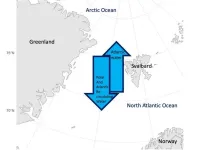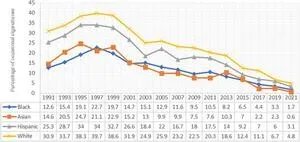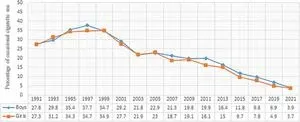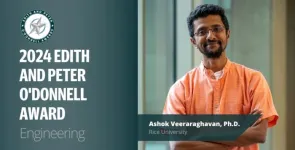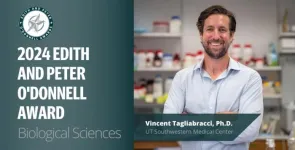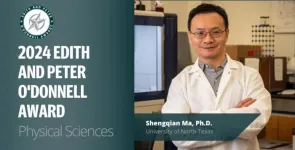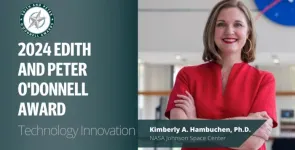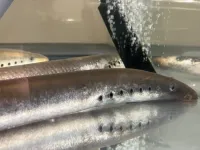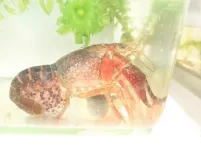PFAS flow equally between Arctic Ocean and Atlantic Ocean, study finds
2024-01-10
(Press-News.org) The frigid Arctic Ocean is far removed from the places most people live, but even so, “forever chemicals” reach this remote landscape. Now, research in ACS’ Environmental Science & Technology Letters suggests that per- and polyfluoroalkyl substances (PFAS) won't stay there indefinitely. Instead, they are transported in a feedback loop, with the Arctic Ocean potentially exporting as many PFAS to the North Atlantic Ocean as it receives, circulating the compounds around the world.
To get to the Arctic Ocean, some PFAS hitch a ride in the air and fall onto the ocean’s surface, but others enter from adjacent oceans. The potential impact of these compounds on marine organisms depends on what PFAS are present and how much, which are ever-changing as water flows between the Arctic Ocean and the North Atlantic Ocean. These waterbodies are connected by the Fram Strait, which sits to the northeast of Greenland near the Svalbard archipelago. Warm water travels north on the eastern side of the strait, and cold water flows south along the western side, providing a dynamic gateway for PFAS transportation. So, Rainer Lohmann and colleagues wanted to track the movement of PFAS in this region and identify how water circulation influences the mix of contaminants in the Arctic Ocean.
The researchers deployed passive sampling systems, which took up PFAS into a sorbent-filled microporous membrane from water as it flowed past. They put the systems at three locations in the Fram Strait, and at four depths in each location. After a year, the team retrieved the systems and measured the collected PFAS using liquid chromatography-mass spectrometry. The researchers overserved that:
Ten PFAS were detected in at least one passive sampler, however, one substance detected in the area by previous research teams wasn’t among them.
Two compounds known as PFOA and PFOS, which are being phased out, were present at the highest levels. Newer, short-chain PFAS were also routinely present.
Surprisingly, several PFAS were found in water below 3,000 feet deep. The team suggests that these compounds could have gotten there by attaching to particles as they fell to the seafloor.
The team calculated the amounts of PFAS flowing in each direction through the Fram Strait. Their data showed that in one year around 123 tons traveled into the Arctic Ocean and about 110 tons moved into the Atlantic Ocean. According to the researchers, these values are the largest of any pollutant reported in the strait, demonstrating how significant the back-and-forth circulation of PFAS is in the Arctic Ocean.
The authors acknowledge funding from the University of Rhode Island Sources, Transport, Exposure and Effects of PFAS (STEEP) Superfund Center, and the Alfred Wegener Institute Long Term Ecological Research Hausgarten program.
The paper’s abstract will be available on Jan. 10 at 8 a.m. Eastern time here: http://pubs.acs.org/doi/abs/10.1021/acs.estlett.3c00835
###
The American Chemical Society (ACS) is a nonprofit organization chartered by the U.S. Congress. ACS’ mission is to advance the broader chemistry enterprise and its practitioners for the benefit of Earth and all its people. The Society is a global leader in promoting excellence in science education and providing access to chemistry-related information and research through its multiple research solutions, peer-reviewed journals, scientific conferences, eBooks and weekly news periodical Chemical & Engineering News. ACS journals are among the most cited, most trusted and most read within the scientific literature; however, ACS itself does not conduct chemical research. As a leader in scientific information solutions, its CAS division partners with global innovators to accelerate breakthroughs by curating, connecting and analyzing the world’s scientific knowledge. ACS’ main offices are in Washington, D.C., and Columbus, Ohio.
To automatically receive news releases from the American Chemical Society, contact newsroom@acs.org.
Note: ACS does not conduct research, but publishes and publicizes peer-reviewed scientific studies.
Follow us: Twitter | Facebook | LinkedIn | Instagram
END
ELSE PRESS RELEASES FROM THIS DATE:
2024-01-10
Trailblazing engineer Ashok Veeraraghavan, Ph.D., Professor of Electrical and Computer Engineering and Computer Science, George R. Brown School of Engineering at Rice University, is the recipient of the 2024 Edith and Peter O’Donnell Award in Engineering from TAMEST (Texas Academy of Medicine, Engineering, Science and Technology). He was chosen for his revolutionary imaging technology that seeks to make the invisible visible. View a video on Dr. Veeraraghavan's groundbreaking research here.
Imagine taking a pristine picture through fog, smoke and rain. Imagine taking interior images of the human body through skin, bone ...
2024-01-10
Forward-thinking biochemist Vincent Tagliabracci, Ph.D., Associate Professor at UT Southwestern Medical Center, is the recipient of the 2024 Edith and Peter O’Donnell Award in Biological Sciences from TAMEST (Texas Academy of Medicine, Engineering, Science and Technology). He was chosen for his potentially life-saving research in understanding how enzymes work. View a video on Dr. Tagliabracci's groundbreaking research here.
Dr. Tagliabracci and his team at UT Southwestern Medical Center have shined a new light on an array of physiological processes that rely on enzymes called protein kinases (PKs) and their biological cousins called ...
2024-01-10
A worldwide leader in nanoporous materials research, Shengqian Ma, Ph.D., Professor and Welch Chair in Chemistry, the University of North Texas, is the recipient of the 2024 Edith and Peter O’Donnell Award in Physical Sciences from TAMEST (Texas Academy of Medicine, Engineering, Science and Technology). He was chosen for his innovative work in the field of decontamination. View a video on Dr. Ma's groundbreaking research here.
In a time of growing concern for the Earth and humanity’s ecosystem, Dr. Ma’s work could have an incredibly important impact on environmental and energy sustainability. His research was primarily ...
2024-01-10
A true pioneer in space, robotics engineer Kimberly A. Hambuchen, Ph.D., Deputy Chief, Software, Robotics and Simulation Division at NASA Johnson Space Center, is the recipient of the 2024 Edith and Peter O’Donnell Award in Technology Innovation from TAMEST (Texas Academy of Medicine, Engineering, Science and Technology). She was chosen for her seminal research in developing new methods for making robots more autonomous and usable by humans across a time delay. View a video on Dr. Hambuchen's groundbreaking research here.
Dr. Hambuchen’s research focuses on human-robot ...
2024-01-10
COLUMBUS, Ohio – Teens from larger families have poorer mental health than those with fewer siblings, according to a large analysis of children in the United States and China.
The details of the pattern vary depending on factors such as the spacing of sibling ages and the age of the siblings.
But the fact that the overall pattern was found in both countries is striking, said Doug Downey, lead author of the study and professor of sociology at The Ohio State University.
“Our results couldn’t have been easily predicted before we did the study,” Downey said.
“Other studies have shown that having more siblings ...
2024-01-10
The origin of the vertebrate skull is a topic of much debate among evolutionary biologists. Some believe that the vertebrate head has developed as a result of modification of the segmental elements of the trunk, such as the vertebrae and somites. On the other hand, others believe that the vertebrate head has evolved as a new, unsegment body part, unrelated to other widely observed embryonic segments somites. Interestingly, previous studies on embryos have revealed the presence of some vestiges of somites ...
2024-01-10
Procambarus clarkii is a crustacean species native to American freshwater bodies. Brought to Japan in the 1920s as a feed for frogs, this crustacean has slowly taken over the Japanese freshwaters by predation and propagation. In fact, in 2023, the red-swamp crayfish was designated as an invasive alien species by the Japanese Ministry of the Environment and of the Agriculture, Forestry and Fisheries.
One way to control the growth in population of red-swamp crayfish and the accompanying crisis is to capture the red-swamp crayfish in their reproductive ...
2024-01-10
Research Highlights:
Despite drops in overall cardiovascular disease deaths from 1999-2019, cardiovascular disease deaths in which substance use was cited as a contributing factor increased an average of 4% per year, with the death rate accelerating to 6.2% from 2012-2019.
Prominent increases in cardiovascular deaths associated with substance use were most notable among women, American Indian or Alaskan individuals, younger individuals, rural area residents and users of cannabis and psychostimulants.
Identifying high-risk groups is crucial for prioritizing preventive measures to reduce substance use linked with cardiovascular disease deaths, particularly ...
2024-01-10
CAMBRIDGE, MA -- Sequencing all of the RNA in a cell can reveal a great deal of information about that cell’s function and what it is doing at a given point in time. However, the sequencing process destroys the cell, making it difficult to study ongoing changes in gene expression.
An alternative approach developed at MIT could enable researchers to track such changes over extended periods of time. The new method, which is based on a noninvasive imaging technique known as Raman spectroscopy, doesn’t harm cells and can be performed repeatedly.
Using ...
2024-01-10
HOUSTON – (Jan. 10, 2023) – The brain is the most protected organ in the body, sheathed in a complex and nearly impenetrable barrier of specialized blood vessels. While this particular anatomical setup protects it from outside invaders, it also makes it difficult for researchers to study how specific genes are expressed ⎯ and how such changes in gene expression may lead to disease.
Now Rice University scientists have developed a noninvasive way to monitor gene expression dynamics in the brain, making it easier to investigate brain ...
LAST 30 PRESS RELEASES:
[Press-News.org] PFAS flow equally between Arctic Ocean and Atlantic Ocean, study finds
